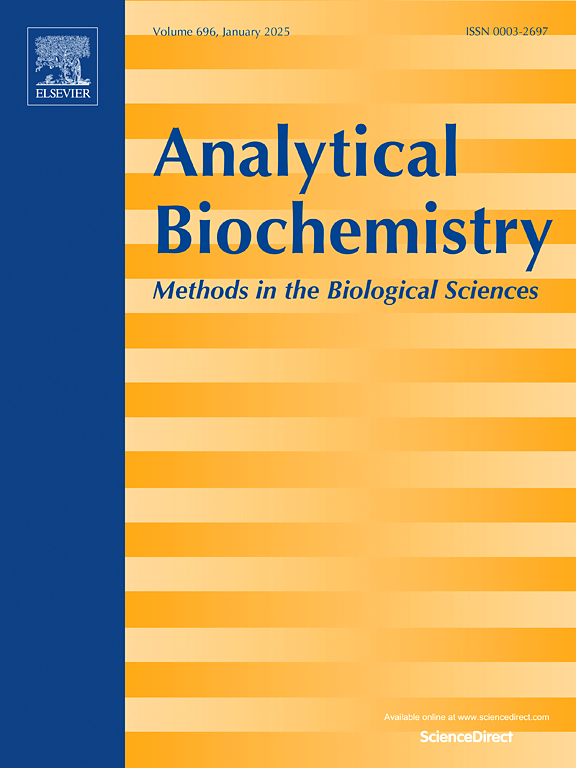Rapid and accurate detection of urinary iodine by single crystal silver iodide sensor
IF 2.5
4区 生物学
Q2 BIOCHEMICAL RESEARCH METHODS
引用次数: 0
Abstract
Iodine deficiency or excess impacts thyroid health, necessitating accurate urinary iodine monitoring. However, existing detection methods face challenges including complicated sample handling, poor anti-interference ability, and the detection range does not cover the range of human urinary iodine concentration. Conventional iodide ion-selective electrode is based on polycrystalline membranes, which has high detection limit and is susceptible to chloride ion interference. It is also not suitable for accurate detection of human urinary iodine. In this study, we introduced a single-crystal AgI electrode for rapid and interference-free detection of urinary iodine. The dense (220) crystal plane of the single-crystal AgI electrode provided excellent selectivity and sensitivity, with a detection limit as low as 59 μg L−1 and good linearity in the range of 100–1000 μg L−1. This fully covers the optimal range of urinary iodine concentrations recommended by the World Health Organization (100–500 μg L−1). Importantly, the single-crystal AgI electrode has excellent resistance to chloride interference, which is a significant improvement over conventional polycrystallaline iodide ion-selective electrodes. Our results show that the electrode has excellent precision, stability and accuracy without interference from common urine ions. This work addresses the limitations of existing methods and provides a rapid, inexpensive and reliable method for urinary iodine testing.

单晶碘化银传感器快速准确检测尿碘
碘缺乏或过量影响甲状腺健康,需要准确的尿碘监测。然而,现有的检测方法面临着样品处理复杂、抗干扰能力差、检测范围不能覆盖人体尿碘浓度范围等挑战。传统的碘离子选择电极是基于多晶膜的,检出限高,易受氯离子干扰。它也不适合用于人体尿碘的准确检测。在这项研究中,我们介绍了一种用于快速无干扰检测尿碘的单晶AgI电极。单晶AgI电极的致密(220)晶面具有良好的选择性和灵敏度,检测限低至59 μg L−1,在100-1000 μg L−1范围内具有良好的线性关系。这完全涵盖了世界卫生组织推荐的尿碘浓度的最佳范围(100-500 μg L−1)。重要的是,单晶AgI电极具有优异的抗氯化物干扰能力,这是传统多晶碘离子选择电极的显著改进。结果表明,该电极具有良好的精密度、稳定性和准确度,不受常见尿液离子的干扰。这项工作解决了现有方法的局限性,提供了一种快速、廉价、可靠的尿碘检测方法。
本文章由计算机程序翻译,如有差异,请以英文原文为准。
求助全文
约1分钟内获得全文
求助全文
来源期刊

Analytical biochemistry
生物-分析化学
CiteScore
5.70
自引率
0.00%
发文量
283
审稿时长
44 days
期刊介绍:
The journal''s title Analytical Biochemistry: Methods in the Biological Sciences declares its broad scope: methods for the basic biological sciences that include biochemistry, molecular genetics, cell biology, proteomics, immunology, bioinformatics and wherever the frontiers of research take the field.
The emphasis is on methods from the strictly analytical to the more preparative that would include novel approaches to protein purification as well as improvements in cell and organ culture. The actual techniques are equally inclusive ranging from aptamers to zymology.
The journal has been particularly active in:
-Analytical techniques for biological molecules-
Aptamer selection and utilization-
Biosensors-
Chromatography-
Cloning, sequencing and mutagenesis-
Electrochemical methods-
Electrophoresis-
Enzyme characterization methods-
Immunological approaches-
Mass spectrometry of proteins and nucleic acids-
Metabolomics-
Nano level techniques-
Optical spectroscopy in all its forms.
The journal is reluctant to include most drug and strictly clinical studies as there are more suitable publication platforms for these types of papers.
 求助内容:
求助内容: 应助结果提醒方式:
应助结果提醒方式:


